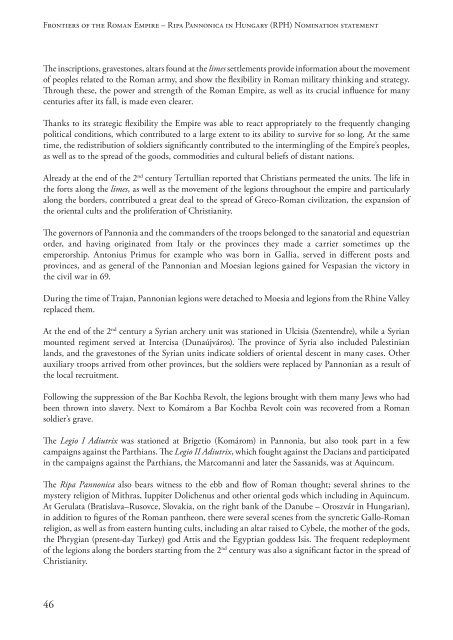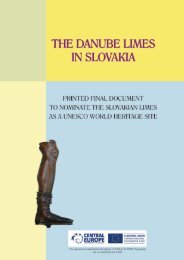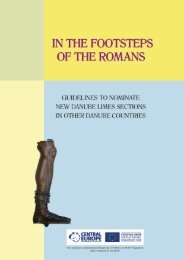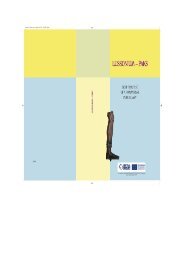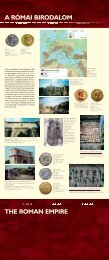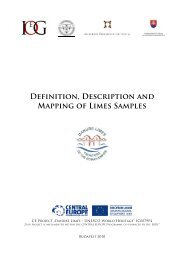the PDF version! - Danube Limes
the PDF version! - Danube Limes
the PDF version! - Danube Limes
You also want an ePaper? Increase the reach of your titles
YUMPU automatically turns print PDFs into web optimized ePapers that Google loves.
Frontiers of <strong>the</strong> Roman Empire – Ripa Pannonica in Hungary (RPH) Nomination statement<br />
The inscriptions, gravestones, altars found at <strong>the</strong> limes settlements provide information about <strong>the</strong> movement<br />
of peoples related to <strong>the</strong> Roman army, and show <strong>the</strong> flexibility in Roman military thinking and strategy.<br />
Through <strong>the</strong>se, <strong>the</strong> power and strength of <strong>the</strong> Roman Empire, as well as its crucial influence for many<br />
centuries after its fall, is made even clearer.<br />
Thanks to its strategic flexibility <strong>the</strong> Empire was able to react appropriately to <strong>the</strong> frequently changing<br />
political conditions, which contributed to a large extent to its ability to survive for so long. At <strong>the</strong> same<br />
time, <strong>the</strong> redistribution of soldiers significantly contributed to <strong>the</strong> intermingling of <strong>the</strong> Empire’s peoples,<br />
as well as to <strong>the</strong> spread of <strong>the</strong> goods, commodities and cultural beliefs of distant nations.<br />
Already at <strong>the</strong> end of <strong>the</strong> 2 nd century Tertullian reported that Christians permeated <strong>the</strong> units. The life in<br />
<strong>the</strong> forts along <strong>the</strong> limes, as well as <strong>the</strong> movement of <strong>the</strong> legions throughout <strong>the</strong> empire and particularly<br />
along <strong>the</strong> borders, contributed a great deal to <strong>the</strong> spread of Greco-Roman civilization, <strong>the</strong> expansion of<br />
<strong>the</strong> oriental cults and <strong>the</strong> proliferation of Christianity.<br />
The governors of Pannonia and <strong>the</strong> commanders of <strong>the</strong> troops belonged to <strong>the</strong> sanatorial and equestrian<br />
order, and having originated from Italy or <strong>the</strong> provinces <strong>the</strong>y made a carrier sometimes up <strong>the</strong><br />
emperorship. Antonius Primus for example who was born in Gallia, served in different posts and<br />
provinces, and as general of <strong>the</strong> Pannonian and Moesian legions gained for Vespasian <strong>the</strong> victory in<br />
<strong>the</strong> civil war in 69.<br />
During <strong>the</strong> time of Trajan, Pannonian legions were detached to Moesia and legions from <strong>the</strong> Rhine Valley<br />
replaced <strong>the</strong>m.<br />
At <strong>the</strong> end of <strong>the</strong> 2 nd century a Syrian archery unit was stationed in Ulcisia (Szentendre), while a Syrian<br />
mounted regiment served at Intercisa (Dunaújváros). The province of Syria also included Palestinian<br />
lands, and <strong>the</strong> gravestones of <strong>the</strong> Syrian units indicate soldiers of oriental descent in many cases. O<strong>the</strong>r<br />
auxiliary troops arrived from o<strong>the</strong>r provinces, but <strong>the</strong> soldiers were replaced by Pannonian as a result of<br />
<strong>the</strong> local recruitment.<br />
Following <strong>the</strong> suppression of <strong>the</strong> Bar Kochba Revolt, <strong>the</strong> legions brought with <strong>the</strong>m many Jews who had<br />
been thrown into slavery. Next to Komárom a Bar Kochba Revolt coin was recovered from a Roman<br />
soldier’s grave.<br />
The Legio I Adiutrix was stationed at Brigetio (Komárom) in Pannonia, but also took part in a few<br />
campaigns against <strong>the</strong> Parthians. The Legio II Adiutrix, which fought against <strong>the</strong> Dacians and participated<br />
in <strong>the</strong> campaigns against <strong>the</strong> Parthians, <strong>the</strong> Marcomanni and later <strong>the</strong> Sassanids, was at Aquincum.<br />
The Ripa Pannonica also bears witness to <strong>the</strong> ebb and flow of Roman thought; several shrines to <strong>the</strong><br />
mystery religion of Mithras, Iuppiter Dolichenus and o<strong>the</strong>r oriental gods which including in Aquincum.<br />
At Gerulata (Bratislava–Rusovce, Slovakia, on <strong>the</strong> right bank of <strong>the</strong> <strong>Danube</strong> – Oroszvár in Hungarian),<br />
in addition to figures of <strong>the</strong> Roman pan<strong>the</strong>on, <strong>the</strong>re were several scenes from <strong>the</strong> syncretic Gallo-Roman<br />
religion, as well as from eastern hunting cults, including an altar raised to Cybele, <strong>the</strong> mo<strong>the</strong>r of <strong>the</strong> gods,<br />
<strong>the</strong> Phrygian (present-day Turkey) god Attis and <strong>the</strong> Egyptian goddess Isis. The frequent redeployment<br />
of <strong>the</strong> legions along <strong>the</strong> borders starting from <strong>the</strong> 2 nd century was also a significant factor in <strong>the</strong> spread of<br />
Christianity.<br />
46


